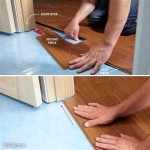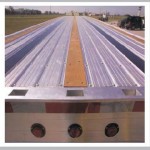White Ash Laminate Flooring: A Comprehensive Overview
White ash laminate flooring offers a compelling blend of aesthetic appeal, durability, and cost-effectiveness, making it a popular choice for homeowners and commercial property managers alike. This type of flooring replicates the look of natural white ash wood, a hardwood prized for its light color and subtle grain patterns, but at a significantly lower price point and with enhanced resilience to wear and tear. Understanding the composition, benefits, installation considerations, and maintenance requirements of white ash laminate flooring is crucial for making an informed decision about its suitability for a specific space.
Laminate flooring, in general, is a multi-layer synthetic flooring product fused together through a lamination process. The core layer typically consists of high-density fiberboard (HDF) or medium-density fiberboard (MDF), providing stability and resistance to indentation. Above this core lies the decorative layer, a high-resolution photographic image of white ash wood. This image is crucial for achieving the realistic appearance of the flooring. An overlay, typically composed of melamine resin, protects the decorative layer from scratches, stains, fading, and moisture. A backing layer, often made of melamine or similar material, further stabilizes the flooring and provides a moisture barrier underneath.
Understanding the Key Benefits of White Ash Laminate
The popularity of white ash laminate flooring stems from its numerous advantages over other flooring options. These benefits encompass aesthetic qualities, practical functionality, and economic considerations. A thorough understanding of these advantages allows consumers to weigh the pros and cons effectively against their individual needs and priorities.
One of the primary attractions of white ash laminate flooring is its aesthetic versatility. The light, neutral color of white ash lends itself well to a wide range of interior design styles, from modern minimalist to Scandinavian-inspired to traditional farmhouse. It brightens up spaces, creating a sense of openness and airiness. The subtle grain patterns, meticulously replicated in the decorative layer, add visual interest without being overwhelming. This adaptability allows white ash laminate to complement various furniture styles, wall colors, and decorative accessories.
Beyond aesthetics, durability is a significant advantage. The protective overlay resists scratches, dents, and fading better than many hardwood floors. This makes it an ideal choice for high-traffic areas, such as hallways, living rooms, and kitchens. Many laminate flooring products are also resistant to staining from spills and pet accidents, further enhancing their practicality for busy households. The durability also translates to a longer lifespan, contributing to the overall value proposition.
Cost-effectiveness is another key benefit. Compared to solid hardwood or even engineered hardwood flooring, laminate flooring is significantly less expensive. This affordability extends beyond the initial purchase price, as laminate flooring often requires less specialized installation and can be installed as a DIY project, further reducing costs. The lower cost makes it an accessible option for those on a budget or for large areas where hardwood might be prohibitively expensive.
Ease of maintenance is another compelling advantage. White ash laminate flooring is relatively easy to clean and maintain. Regular sweeping or vacuuming is sufficient to remove dust and debris. For spills or stains, a damp mop with a mild detergent is typically all that is needed. Unlike hardwood, laminate does not require waxing or polishing, saving time and effort in the long run. The stain resistance and ease of cleaning make it a practical choice for families with children and pets.
Installation Considerations for White Ash Laminate
While white ash laminate flooring is often marketed as a DIY-friendly option, proper installation is critical for ensuring its longevity and performance. A poorly installed floor can be prone to problems such as buckling, gapping, and squeaking. Understanding the key installation considerations is crucial for both DIYers and those hiring professional installers.
Acclimation is a vital first step. Laminate flooring needs to acclimate to the temperature and humidity of the room in which it will be installed. This typically involves leaving the boxes of flooring in the room for several days (usually 48 to 72 hours) before installation. This allows the boards to expand or contract, preventing issues after installation due to changes in environmental conditions. Failing to properly acclimate the flooring can lead to significant problems later on.
Subfloor preparation is equally important. The subfloor must be clean, level, and dry. Any imperfections, such as unevenness or loose nails, must be addressed before laying the laminate. Uneven subfloors can cause the laminate to flex and break over time. The subfloor should also be properly sealed to prevent moisture from seeping up and damaging the laminate. Using a self-leveling compound can correct minor imperfections in the subfloor.
The underlayment is another critical component. Underlayment provides a moisture barrier, cushions the flooring, and reduces noise transmission. The type of underlayment will depend on the specific laminate flooring being used and the type of subfloor. Some laminate flooring products come with pre-attached underlayment, simplifying the installation process. Choosing the right underlayment is crucial for ensuring the long-term performance of the floor.
When installing the planks, maintaining consistent expansion gaps around the perimeter of the room is essential. These gaps allow the flooring to expand and contract with changes in temperature and humidity without buckling against the walls. Space is usually maintained with spacers during installation and then covered by baseboards after installation. Proper spacing prevents buckling and ensures the floor lays properly.
Cutting laminate flooring requires specialized tools. A laminate flooring cutter or a circular saw with a fine-tooth blade is recommended. Using the wrong tools can result in chipped or damaged planks. Accurate measurements and precise cuts are essential for a professional-looking installation. Always wear safety glasses and gloves when cutting laminate flooring.
Maintaining White Ash Laminate Flooring
Proper maintenance is key to preserving the beauty and extending the lifespan of white ash laminate flooring. While laminate is relatively low-maintenance, neglecting proper care can lead to damage and reduce its lifespan. Understanding the recommended maintenance practices is essential for keeping the floor looking its best for years to come.
Regular cleaning is the most important aspect of maintenance. Sweeping or vacuuming regularly (at least once a week) removes dust, dirt, and debris that can scratch the surface. Using a vacuum with a soft brush attachment is recommended to avoid scratching the finish. Avoid using vacuums with beater bars, as they can damage the laminate over time.
For spills, clean them up immediately with a damp cloth. Avoid letting liquids sit on the surface, as they can potentially seep into the seams and damage the core of the flooring. For tougher stains, use a laminate floor cleaner specifically designed for this type of flooring. Avoid using harsh chemicals, abrasive cleaners, or scouring pads, as they can damage the protective overlay.
When mopping, use a damp mop, not a wet one. Too much water can seep into the seams and cause the flooring to swell or warp. Wring out the mop thoroughly before using it on the floor. Using a microfiber mop is recommended, as it effectively removes dirt and grime without using excessive water. Always follow the manufacturer's instructions for cleaning.
Protect the flooring from scratches by using furniture pads under the legs of chairs and tables. Avoid dragging heavy objects across the floor. Place mats at entryways to trap dirt and debris that can be tracked into the house. Using area rugs in high-traffic areas can also help protect the flooring from wear and tear.
Avoid using steam mops on laminate flooring. The high heat and moisture can damage the protective overlay and cause the flooring to swell or warp. While some manufacturers may claim their laminate flooring is steam mop-friendly, it is generally best to avoid using steam mops to prevent potential damage. Always refer to the manufacturer's recommendations for cleaning.
By following these maintenance guidelines, white ash laminate flooring can maintain its beauty and durability for many years. Consistent care and preventative measures will protect the investment and ensure the floor remains a valuable asset to the home or commercial space.

Timberwise Ash Olive White Wood Floors Wooden Floor Bedroom Flooring

Assets Llflooring Com Upload W 1000 H F

Ash Wide Plank Flooring Hardwood Vermont

American White Ash Flooring Wood Engineered Ltd Wohimmer Bodenbelag Er Holzboden Wohimmermöbel

Our Latest Obsessions On Luxury Wood

White Ash Laminate End Profile

White Ash Wood Flooring Gl11 Floorco

Fast Floors White Ash Laminate Flooring

White Ash 5mm Spc Lvt Heavy Duty 0 5 Wear Layer Flooring Built In Underlay

White Ash Wood Flooring Enterprise S
Related Posts








